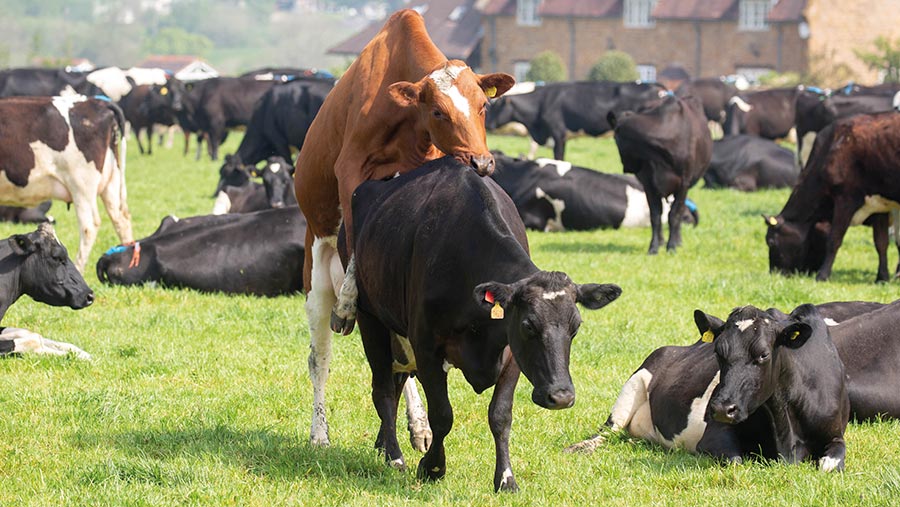Advice on how to maintain a tight calving block
 © Tim Scrivener
© Tim Scrivener Achieving a tight calving block is key to the success of a block-calving system.
Typically, farms will aim for a calving period of nine to 12 weeks, with 75-80% of eligible cows in-calf in the first six weeks, and no more than 5-10% cows empty after 12 weeks of mating.
These targets can be a challenge and require cow management and health to be in top order. Planning and putting in effort in upfront, along with getting everything in place before mating, are essential to achieve good results.
See also: Uterine disease in dairy cows: symptoms, causes and reducing risk
About the author
 Each month, we bring practical advice from an XLVets practice on a range of different subjects. Guy Tomlinson of Daleside Veterinary Group offers expert advice on effective fertility management in block-calving herds.
Each month, we bring practical advice from an XLVets practice on a range of different subjects. Guy Tomlinson of Daleside Veterinary Group offers expert advice on effective fertility management in block-calving herds.
If problems occur during mating, they will affect all the cows in the block because you are trying to get them all in-calf at the same time.
There is very little time to correct an issue once mating has started, so taking a “wait and see how it goes” approach is very risky. The adage “failing to prepare is preparing to fail” is very relevant to block-calving fertility.
Optimal body condition
Preparation for mating starts at the end of the previous lactation. Ensuring cows are dried off in optimal body condition is key to a straightforward calving, which in turn is key for good fertility at mating.
Cows should be dried off with a body condition score of 2.5-3.5. If altering body condition is necessary, late lactation is the best time to try and do this by adjusting feeding and dry-off timing.
Cows that are underconditioned at calving may have less energy and strength. As a result, they are more likely to have a drawn-out calving, and be slower to recover and start eating after calving.
This increases the risk of cows having a negative energy balance and developing endometritis, which in turn impacts fertility at mating.
Cows that are overconditioned at calving are more likely to have a difficult calving, retained cleansing, endometritis and reduced appetite.
All these factors will affect their fertility at mating. However, trying to reduce the body condition of these cows once they are dry (particularly in the last three weeks pre-calving) will have a detrimental effect on their performance. Instead, focus on maintaining feed intake as much as possible pre- and post-calving.
Providing additional care and attention will enable conditions such as ketosis, endometritis and milk fever to be detected and treated early.
Milk fever, even at a subclinical level, will affect cow performance and fertility after calving. Managing dietary cation anion balance (DCAB) in the transition diet in the three weeks pre-calving is key to minimise the risk.
Control of infectious disease
Infectious diseases such as bovine viral diarrhoea, leptospirosis and infectious bovine rhinotracheitis have significant consequences for herd fertility.
Work with your vet to regularly monitor these diseases and have a robust control plan in place to manage this risk.
Uterine infections after calving can also cause fertility problems, so maintaining hygiene in the calving area during the busy calving period is essential.
Good nutrition also plays a key role in reducing the chance of metritis and endometritis.
Genetic selection
Choosing the right genetics can also play a part. Selecting easy-calving bulls – especially when using beef breeds – reduces the risk of large calves and difficult calvings.
This helps to give the cow a good start to lactation and the best chance to get back in-calf.
The use of bulls with short gestation in the later stages of mating can also help cows that get in-calf later in the block to calve earlier. This then gives them more time after calving to get back in-calf.
Monitoring during mating
Although there is little time to correct any issues once mating has started, it is still worth monitoring fertility performance during mating.
If there is a problem, then at least it can be detected as early as possible to give you time to intervene.
Aim for the following:
- Submission rate – at least 90% of eligible cows should be served in the first three weeks
- Repeats – for a 60% conception rate, less than 40% of cows served in the first three weeks should repeat in the second three weeks (assuming all those that did not hold are seen bulling)
- Eight weeks into mating, pregnancy-diagnose (PD) all cows served in the first three weeks that have not repeated, to assess conception rate
- PD all cows after mating to assess calving pattern and provide accurate calving dates.
Interventions
The following three interventions can help give cows the best chance to return to cyclicity after calving and get in-calf as early in the block as possible:
- Carry out checks on all cows two to three weeks after calving to ensure metritis or endometritis is detected and treated early. Recording cases also allows the rate of endometritis to be monitored.
- Start monitoring cows for heats three to four weeks before the start of mating, using heat-detection aids such as scratch cards, pressure-sensitive devices or even collars or pedometers. Any cows not observed on heat can be examined and treated/synchronised by your vet just before mating starts. This helps to maximise the submission rate in the first three weeks of mating. If you are using artificial insemination, this can then be repeated on any cows that have not been served after three weeks of mating.
- If you are using a bull, get him fertility-tested two months before he is going to be used, to ensure he is fit and fully fertile.
